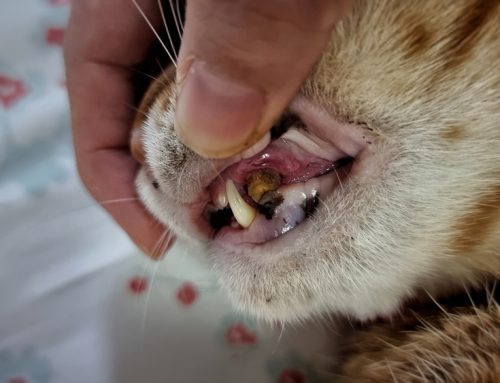Fleas are one of the most common parasites of dogs and cats. These insects live on the skin and feed on the blood of the host. Animals infested with fleas are extremely itchy due to inflammation caused by the flea bites.
In severe cases, the pet may develop Flea Allergy Dermatitis (FAD), an allergy to flea saliva that causes hair loss, inflammation, open sores and skin infection.
Fleas can cause significant illness in the host animal. Pets with heavy infestations are at risk for flea anemia, a life-threatening condition in which the fleas drink so much blood that they depleat the animal’s total blood volume. Very young or very old animals are at the greatest risk of dying from this condition. Additionally, fleas carry many diseases that can affect animals and humans, including Tapeworms, Bartonella and the Plague.
Animals pick up fleas in the environment and directly from other animals. Fleas are excellent jumpers, leaping heights of up to 8 inches and distances of up to 13 inches, 200 times the size of the flea itself. Fleas in the environement wait until they feel the vibrations of a passing host, and then leap onto the animal to search for a blood meal. Once a suitable host is found, the fleas rapidly reproduces itself, so a single flea can turn into a flea infestation in just a matter of weeks.
There are four stages to the flea life cycle: Eggs, Larvae, Pupae and Adults. Adult fleas lay eggs on the host animal, but the fleas do not stick to the animal and tend to fall off wherever the animal roams. The eggs will contaminate carpets, furniture, and yard areas, but are most concentrated in areas where the animal sleeps or rests. Eggs are hardy and can survive in the environment in conditions that would kill an adult flea. Under ideal conditions, eggs will hatch 2 days to 2 weeks from the time they were laid.
Flea larvae hatch out of eggs and feed on skin cells, digested blood (flea feces) and other debris in the environment. Larvae live primarily in carpet, furniture, and dirt. They are blind and seek dark areas, so are more concentrated in crevices and other sheltered environments. Depending on environmental conditions, larvae mature to pupae in a few weeks to several months.
The pupae stage is the stage in which the larvae spins a cacoon and matures to an adult flea. This stage generally lasts 7-10 days, but can last longer if environmental conditions are not good. Cacoons are resistant to environmental factors and pupae can over-winter in the shelter of the cacoon. The adult flea will emerge from the cacoon when it detects the vibration of a passition potential host.
The average life span for an adult flea is 100 days, but can last up to a year. During this time the flea will feed several times per day if blood meals are available. However, a flea can also live up to 12 months in between meals, ensuring survival even if food is scarce. Females lay up to 20 eggs per day, allowing the flea population to grow exponentially. Just 10 female fleas create a population of 250,000 fleas in just 30 days. Adults themselves make up less than 5% of the entire flea population in an environment, so when adults are spotted on an animal, it’s a sure sign of a flea infestation.
So what do we do about this problem? Fleas are easier to prevent than they are to treat. There are a multitude of preventative products on the market. The most effective products to prevent or kill fleas on pets are spot-on treatments. Although these products look very much alike, they have very different methods of action.
Permethrin-only products are available over the counter at a very inexpensive cost, but although permethrin is an effective insecticide, it breaks down in light and washes off with water. Permethrin is also extremely toxic to cats if ingested. More effective topicals use either a different insecticide altogether, or combine permethrin with another insecticide to increase the efficacy and help keep the product on the pet through baths and outdoor play. Most topical products are applied once monthly to your pet year-round to provide ongoing protection.
Some flea preventatives include an Insect Growth Regulator (IGR). This is a drug that does nothing to kill the adult flea, but instead sterilizes the eggs to prevent an ongoing infestation in the environment. IGRs used alone only work in the absence of a current flea problem. They are much more effective when combined with an insecticide that also kills and/or repels the adult flea.
Some flea products contain additional drugs to help protect your pet from other parasites as well, such as ticks, intestinal parasites, mosquitos, heartworms or mites. Talk to your vet to discuss the most effective flea control currently available and to get help choosing a product that meets your pet’s lifestyle needs.
Finally, because flea preventions for your pet only treat adult fleas (only 5% of the total flea population), environmental control is important to stop the ongoing life-cycle. No product exists to kill flea eggs, so it is important to do your best to eliminate as many of these eggs as possible through vacuuming carpets (discarding the dust bag afterwards) and laundering bedding. To treat any fleas you may have missed, treat your home and yard with environmental sprays to help kill larva before they mature into adults. See your veterinarian or pest control expert for more advice on environmental control.
Fleas make our lives miserable. They can be very challenging to get rid of once established in a household, but they are treatable. By using effective preventative products year round and environmental control as necessary, you can protect your pet from this dreaded but very common parasite.




Leave A Comment